Yamaha GP1200R Manual
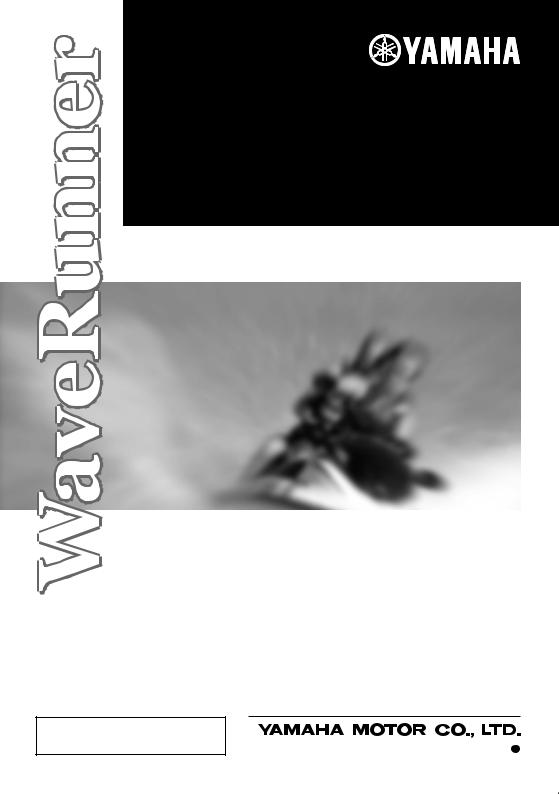
2002 WaveRunner
GP1200R
OWNER’S/OPERATOR’S
MANUAL
READ THIS MANUAL |
|
CAREFULLY BEFORE OPERATION! |
F0X-F8199-72 |
|
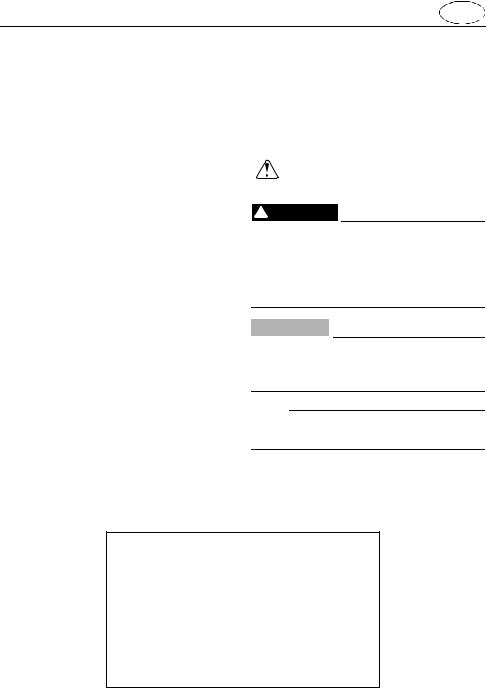
E
EJU00989
To the owner/operator
Thank you for choosing a Yamaha watercraft.
This Owner’s/Operator’s Manual contains information you will need for proper operation, maintenance, and care. A thorough understanding of these simple instructions will help you to obtain maximum enjoyment from your new Yamaha. If you have any questions about the operation or maintenance of your watercraft, please consult a Yamaha dealer.
Because Yamaha has a policy of continuing product improvement, this product may not be exactly as described in this Owner’s/ Operator’s Manual. Specifications are subject to change without notice.
This manual should be considered a permanent part of this watercraft and should remain with it even if the watercraft is subsequently sold.
EJU00990
Important manual information:
In this manual, information of particular importance is distinguished in the following ways:
The Safety Alert Symbol means ATTENTION! BECOME ALERT! YOUR SAFETY IS INVOLVED!
 WARNING
WARNING
Failure to follow WARNING instructions could result in severe injury or death to the machine operator, passenger, a bystander, or a person inspecting or repairing the watercraft.
CAUTION:
A CAUTION indicates special precautions that must be taken to avoid damage to the watercraft.
NOTE:
A NOTE provides key information to make procedures easier or clearer.
EJU00991
WaveRunner GP1200R
OWNER’S/OPERATOR’S MANUAL ©2001 by Yamaha Motor Co., Ltd.
1st Edition, July 2001 All rights reserved.
Any reprinting or unauthorized use without the written permission of Yamaha Motor Co., Ltd.
is expressly prohibited. Printed in USA

EJU00992
CONTENTS
GENERAL AND SAFETY
INFORMATION
FEATURES AND FUNCTIONS
OPERATION
MAINTENANCE AND CARE
TROUBLESHOOTING AND
EMERGENCY PROCEDURES
APPENDIX
E
1
2
3
4
5
6
READ THIS OWNER’S/OPERATOR’S MANUAL CAREFULLY BEFORE
OPERATING YOUR WATERCRAFT.
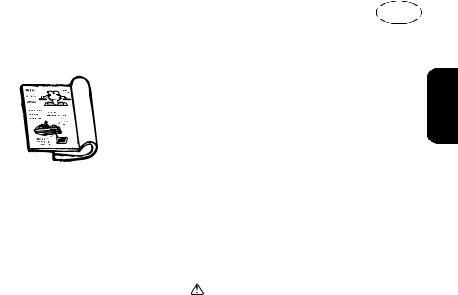
|
|
|
|
E |
|
|
|
EJU00993 |
|
|
|
|
GENERAL AND |
|
|
|
|
SAFETY |
1 |
|
|
|
INFORMATION |
|
|
|
|
Identification numbers ............................ |
1-1 |
|
|
|
Primary Identification (PRI-ID) |
|
|
|
|
number ................................................... |
1-1 |
|
|
|
Hull Identification Number (HIN) ............ |
1-1 |
|
|
|
Engine serial number ............................. |
1-1 |
|
|
|
Important labels ....................................... |
1-2 |
|
|
|
Label location ......................................... |
1-2 |
|
|
|
Warning labels ....................................... |
1-3 |
|
|
|
Caution labels ........................................ |
1-6 |
|
|
|
Other labels ............................................ |
1-7 |
|
|
|
Safety information ............................. |
1-8 |
|
|
|
Limitations on who may operate the |
|
|
|
|
watercraft ................................................ |
1-8 |
|
|
|
Cruising limitations ................................. |
1-9 |
|
|
|
Operation requirements ....................... |
1-10 |
|
|
|
Recommended equipment .................. |
1-12 |
|
|
|
Hazard information .............................. |
1-13 |
|
|
|
Watercraft characteristics .................... |
1-13 |
|
|
|
Safe boating rules ................................. |
1-14 |
|
|
|
Enjoy your watercraft responsibly ...... |
1-15 |
|
|
|
|
|
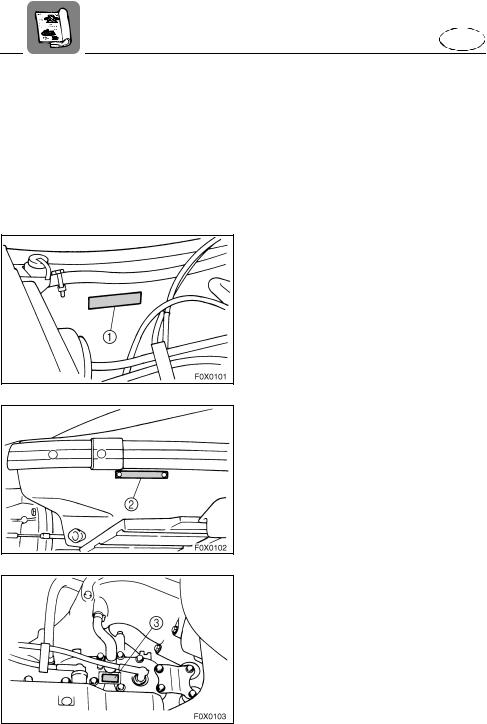
E
EJU00994
Identification numbers
Record your Primary Identification (PRIID) number, Hull Identification Number (HIN) and engine serial number in the spaces provided, to assist you in ordering spare parts from a Yamaha dealer. Also record and keep these ID numbers in a separate place in case your watercraft is stolen.
EJU00995
Primary Identification (PRI-ID) number
The PRI-ID number is stamped on a label 1 attached to the inside of the engine compartment.
EJU00996
Hull Identification Number (HIN)
The HIN is stamped on a plate 2 attached to the hull on the aft, starboard side.
EJU00997
Engine serial number
The engine serial number is stamped on a label 3 attached to the engine unit.
1-1
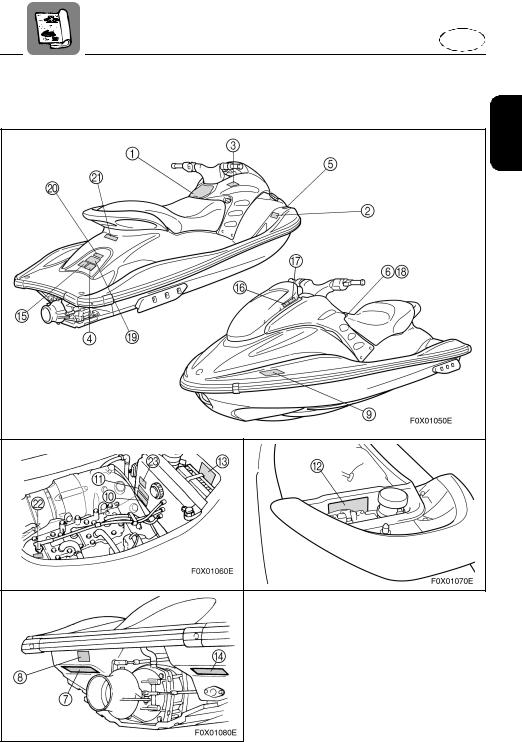
E
EJU00998
Important labels
EJU01351
Label location
1-2

E
EJU01352
Warning labels
1
1-3

E
2 |
3 |
4
5
1-4

E
6
7 |
8 |
9
0 |
A |
1-5
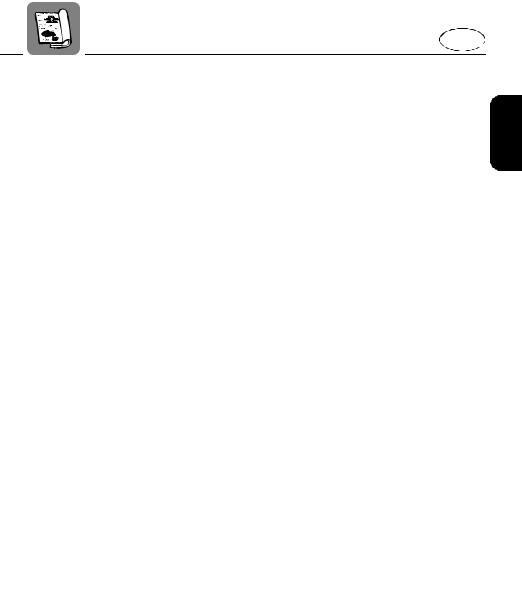
E
EJU01353
Caution labels
B C
D
E F
G
1-6
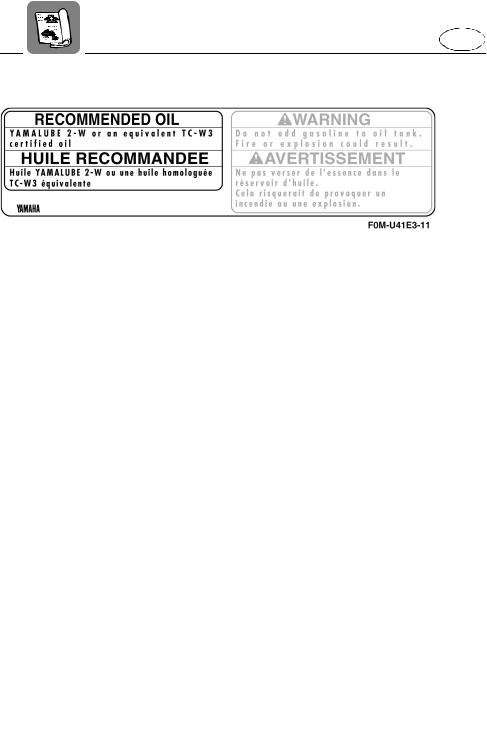
E
EJU01354
Other labels
H
I
J
K
L M
1-7

E
EJU00999 |
EJU01000 |
Safety information |
Limitations on who may |
|
operate the watercraft |
The safe use and operation of this watercraft is dependent upon the use of proper riding techniques, as well as upon the common sense, good judgment, and expertise of the operator. Before using this watercraft, make sure that its use is permitted under local laws, bylaws and regulations and always operate the watercraft in full conformity with any requirements and limitations imposed. Every operator should know the following requirements before riding the watercraft.
●Before operating the watercraft, read this Owner’s/Operator’s Manual, the Riding Practice Guide, and all warning and caution labels on the watercraft. These materials should give you an understanding of the watercraft and its operation.
●Never allow anyone to operate this watercraft until they too have read this Owner’s/ Operator’s Manual, the Riding Practice Guide and all warning and caution labels.
●Yamaha recommends a minimum operator age of 16 years old.
Adults must supervise use by minors. Know your local operator age and training requirements.
●This watercraft is designed to carry the operator and one passenger. Never exceed the maximum load limit or allow more than 2 persons to ride the watercraft at one time.
Maximum load: 160 kg (353 lb)
Load is the total weight of cargo, operator and passenger.
●Do not operate the watercraft with a passenger on board until you have considerable practice and experience riding alone. Operating the watercraft with a passenger requires more skill. Take the time to become accustomed to the handling characteristics of the watercraft before trying any difficult maneuvers.
1-8

E
EJU01001
Cruising limitations
●Scan constantly for people, objects, and other watercraft. Be alert for conditions that limit your visibility or block your vision of others.
●Operate defensively at safe speeds and keep a safe distance away from people, objects, and other watercraft.
●Do not follow directly behind watercraft or other boats.
●Do not go near others to spray or splash them with water.
●Avoid sharp turns or other maneuvers that make it hard for others to avoid you or understand where you are going.
●Avoid areas with submerged objects or shallow water.
●Ride within your limits and avoid aggressive maneuvers to reduce the risk of loss of control, ejection, and collision.
●This is a high performance boat—not a toy. Sharp turns or jumping wakes or waves can increase the risk of back/spinal injury (paralysis), facial injuries, and broken legs, ankles and other bones. Do not jump wakes or waves.
●Do not operate the watercraft in rough water, bad weather or when visibility is poor; this may lead to an accident causing injury or death. Be alert to the possibility of adverse weather. Take note of weather forecasts and the prevailing weather conditions before setting out on your watercraft.
●As with any water sport, you should not ride your watercraft without someone else near by. If you ride further than swimming distance from shore, you should ride by another boat or watercraft, but make sure you stay a safe distance away. It’s good common sense!
●Never operate in water that is less than 60 cm (2 ft) deep, otherwise you increase your chance of hitting a submerged object, which could result in injury.
1-9

E
●This watercraft is not equipped with lighting required for night operation. Do not operate the watercraft after sunset or before dawn, otherwise you increase the risk of colliding with another boat, which could result in severe injury or death.
EJU01002
Operation requirements
●All riders must wear an authorityapproved PFD that is suitable for personal watercraft use.
●Wear protective clothing. Severe internal injuries can occur if water is forced into body cavities as a result of falling into water or being near the jet thrust nozzle.
Normal swimwear does not adequately protect against forceful water entry into rectum or vagina. All riders must wear a wetsuit bottom or clothing that provides equivalent protection. Such clothing includes thick, tightly woven, sturdy and snug-fitting apparel such as denim, but does not include spandex or similar fabrics, like those used in bicycle shorts.
1Authority-approved PFD
2Wetsuit bottom
●Eye protection is recommended to keep wind, water, and glare from the sun out of your eyes while you operate your watercraft. Restraining straps for eyewear are made which are designed to float should your eyewear fall in the water.
Footwear and gloves are recommended.
1-10
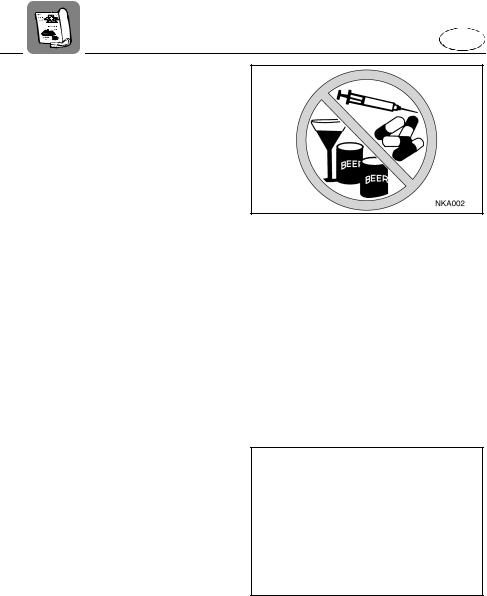
E
●You must decide whether to wear a helmet while you ride for recreation. You should know that a helmet could help protect you in certain kinds of accidents and that it could injure you in others.
A helmet is designed to provide some head protection. Although helmets cannot protect against all foreseeable impacts, a helmet might reduce your injuries in a collision with a boat or other obstacle.
A helmet may have potential safety hazards, as well. Falling into the water could risk the chance of the helmet catching water, commonly known as “bucketing,” and the resulting strain on your neck could cause choking, severe and permanent neck injuries, or death. A helmet could also increase the risk of an accident if it reduces your vision or hearing, or if it distracts you or increases your fatigue.
How should you decide if a helmet’s potential safety benefits outweigh its potential risks for you? Consider your particular riding conditions. Consider factors such as your riding environment and your riding style and ability. Also consider the likelihood of traffic congestion, and the water surface conditions. If you decide to wear a helmet based upon your riding circumstances, choose one carefully. Look for a helmet designed for personal watercraft use, if possible. If you will be engaging in closed-course competition, follow the helmet requirements of the sanctioning organization.
●NEVER operate the watercraft after consuming alcohol or taking other drugs.
●For reasons of safety and proper care of the watercraft, always perform the preoperation checks listed on page 3-5 before operating the watercraft.
●The operator and passenger should always keep both feet in the footwell when the watercraft is in motion. Lifting your feet increases your chances of losing your balance, and your feet being hit by objects outside the watercraft. Do not give a ride to a child whose feet cannot reach the floor of the footwell.
●Passenger should firmly hold on to the operator.
●Always consult your doctor on whether it is safe for you to ride this watercraft if you are pregnant or in poor health.
1-11

E
●Do not attempt to modify this watercraft! Modifications to your watercraft may reduce safety and reliability, and render the watercraft unsafe or illegal for use.
●Attach the engine shut-off cord (lanyard) to wrist and keep it free from the handlebars so that the engine stops if the operator falls off. After riding, remove the engine shut-off cord from the watercraft to avoid accidental starting or unauthorized use by children or others.
●Scan carefully for swimmers and stay away from swimming areas. Swimmers are hard to see and you could accidentally hit someone in the water.
●Avoid being hit by another boat! You should always take the responsibility to watch for traffic; other boaters may not be watching for you. If they do not see you, or you maneuver more quickly than other boaters expect, you risk a collision.
●Maintain a safe distance from other boats or watercraft, and also watch for boats’ ski ropes or fishing lines. Obey the “Safe boating rules” and be sure to check behind you before making a turn. (See Safe boating rules on page 1-14.)
EJU01382
Recommended equipment
The following items should be carried on board your watercraft:
●Sound-signaling device
You should carry a whistle or other soundsignaling device that can be used to signal other boats.
●Visual distress signals
It is recommended that an authorityapproved pyrotechnic device be stored in a waterproof container on your watercraft. A mirror can also be used as an emergency signal. Contact your Yamaha dealer for more information.
●Watch
A watch is helpful so you will know how long you have been operating.
●Towline
A towline can be used to tow a disabled watercraft in an emergency.
1-12
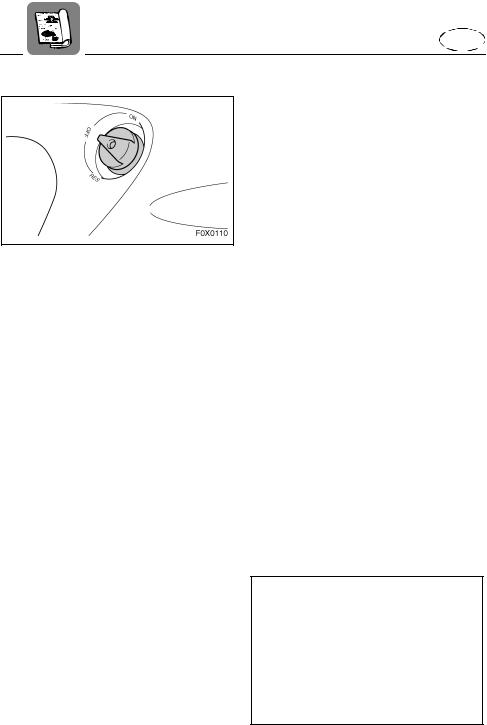
E
EJU01003
Hazard information
●When transporting or storing your watercraft, always place the fuel cock knob in the “OFF” position, otherwise gasoline may overflow from the carburetor.
●Never start the engine or let it run for any length of time in an enclosed area. Exhaust fumes contain carbon monoxide, a colorless, odorless gas that may cause loss of consciousness and death within a short time. Always operate the watercraft in an open area.
EJU01004
Watercraft characteristics
●Jet thrust turns the watercraft. Releasing the throttle completely produces only minimum thrust. If you are traveling at speeds above trolling, you will have rapidly decreasing ability to steer without throttle. You may still have some turning ability immediately after releasing the throttle, but once the engine slows down, the watercraft will no longer respond to handlebar input until you open the throttle again or you reach a trolling speed. Practice turning in an open area without obstructions until you have a good feel for this maneuver.
●This watercraft are water-jet propelled. The jet pump is directly connected to the engine. This means that jet thrust will produce some movement whenever the engine is running. There is no “neutral” position.
●Keep away from intake grate 1 while the engine is on. Items such as long hair, loose clothing, or PFD straps can become entangled in moving parts resulting in severe injury or drowning.
●Never insert any object into the jet thrust nozzle 2 while the engine is running. Severe injury or death could result from coming in contact with the rotating parts of the jet pump.
1-13

E
● Stop the engine and remove the clip 3 |
EJU01005 |
||
from the engine shut-off switch 4 before |
Safe boating rules |
||
removing any debris or weeds, which may |
Your Yamaha watercraft is legally consid- |
||
have collected around the jet intake. |
|||
ered a powerboat. Operation of the water- |
|||
|
|
||
|
|
craft must be in accordance with the rules |
|
|
|
and regulations governing the waterway on |
|
|
|
which it is used. |
|
|
|
|
|
1-14

E
EJU01006
Enjoy your watercraft responsibly
You share the areas you enjoy when riding your watercraft with others and with nature. So your enjoyment includes a responsibility to treat these other people, and the lands, waters, and wildlife with respect and courtesy.
Whenever and wherever you ride, think of yourself as the guest of those around you. Remember, for example, that the sound of your watercraft may be music to you, but it could be just noise to others. And the exciting splash of your wake can make waves others won’t enjoy. Avoid riding close to shoreline homes and waterfowl nesting areas or other wildlife areas, and keep a respectful distance from fishermen, other boats, swimmers, and populated beaches. When travel in areas like these is unavoidable, ride slowly and obey all laws.
Remember that pollution can be harmful to the environment. Do not refuel or add oil where a spill could cause damage to nature. Remove your watercraft from the water and move it away from the shoreline before refueling. And keep your surroundings pleasant for the people and wildlife that share the waterways: don’t litter!
When you ride responsibly, with respect and courtesy for others, you help ensure that our waterways stay open for the enjoyment of a variety of recreational opportunities.
1-15
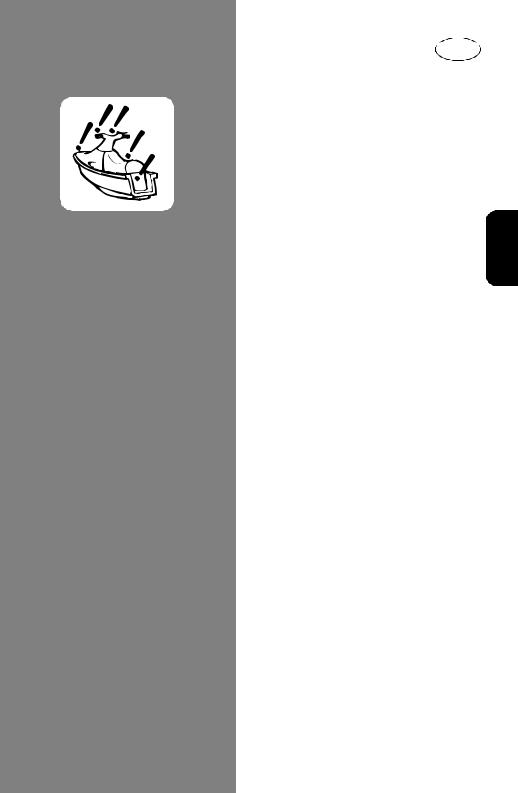
E
EJU01007
FEATURES AND
FUNCTIONS
Location of main components .............. |
2-1 |
|
Operation of controls and other |
|
|
functions ................................................... |
2-5 |
2 |
Seat ........................................................ |
2-5 |
|
Hood ....................................................... |
2-6 |
|
Fuel tank filler cap .................................. |
2-6 |
|
Oil tank filler cap ..................................... |
2-6 |
|
Fuel cock knob ....................................... |
2-7 |
|
Engine stop switch ................................. |
2-8 |
|
Engine shut-off switch ............................ |
2-8 |
|
Choke lever ............................................ |
2-8 |
|
Throttle lever .......................................... |
2-9 |
|
Start switch ............................................. |
2-9 |
|
Cooling water pilot outlet ..................... |
2-10 |
|
Steering system ................................... |
2-10 |
|
Quick Shift Trim System (QSTS) |
|
|
selector ................................................. |
2-11 |
|
Handgrip ............................................... |
2-12 |
|
Engine overheat warning system ........ |
2-13 |
|
Multifunction information center .......... |
2-15 |
|
Tachometer .......................................... |
2-16 |
|
Speedometer ....................................... |
2-16 |
|
Reset button ......................................... |
2-16 |
|
Fuel meter ............................................ |
2-17 |
|
Hour meter ........................................... |
2-17 |
|
Fuel warning indicator .......................... |
2-18 |
|
Oil warning indicator ............................ |
2-18 |
|
Engine overheat warning indicator ...... |
2-19 |
|
Storage compartments ........................ |
2-20 |
|
Yamaha Adjustable Sponson |
|
|
(Y.A.S.) ................................................. |
2-21 |
|

E
EJU01008
Location of main components
1Handlebars
Use to control direction.
2Fuel tank filler cap
3Rope hole
4Footwell
Use to place feet for balance.
5Intake grate
Prevents debris from getting into the jet pump.
6Speed sensor
2-1

E
1Cooling water pilot outlet
Use to verify cooling water flow.
2Bow eye
Use to attach rope for transporting, mooring or towing the watercraft in an emergency.
3Front storage compartment
4Hood
5Jet intake
6Handgrip
7Seat
8Glove compartment
9Yamaha Adjustable Sponson (Y.A.S.)
2-2
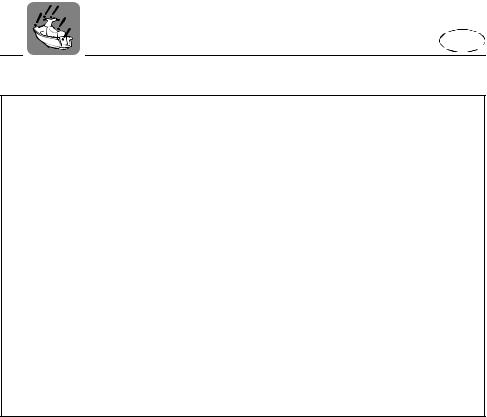
E
1 |
Engine shut-off cord (lanyard) |
8 |
Throttle lever |
|
Attach to wrist so that the engine stops if the |
|
Use to accelerate and decelerate. |
|
operator falls off the watercraft. |
9 |
Choke lever |
2 |
Engine stop switch |
0 |
Oil tank filler cap |
|
Push to stop the engine normally. |
A Fuel cock knob |
|
3 |
Clip |
B Stern drain plugs |
|
|
Insert into the engine shut-off switch to enable |
|
Use to drain water in the bilge when the water- |
|
starting of the engine. |
|
craft is on dry land. |
|
Remove to stop the engine or prevent acci- |
C Jet thrust nozzle |
|
|
dental starting of the engine or unauthorized |
|
Changes the direction of jet thrust according |
|
use of the watercraft. |
|
to handlebar position. |
4 |
Quick Shift Trim System (QSTS) selector |
D Ride plate |
|
|
Use to select the trim angle of the watercraft. |
|
|
5Engine shut-off switch
Remove the clip to stop the engine and disable it from starting.
6Start switch
Push to start the engine.
7Multifunction information center
Use to check watercraft operation.
2-3
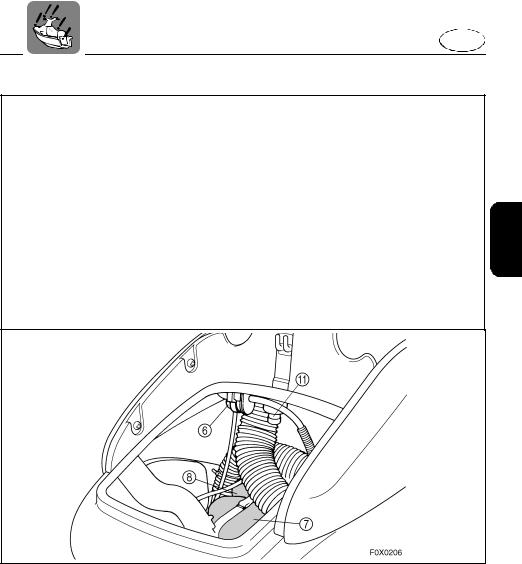
E
1 |
Spark plugs/Spark plug caps |
8 |
Oil tank |
2 |
Electrical box |
9 |
Battery |
|
Protects electrical components from water. |
0 |
Fire extinguisher container |
3 |
Flush hose connector |
A Water separator |
|
|
Use to flush the engine cooling water pas- |
|
|
|
sages. |
|
|
4Spark plug lead
5Muffler
6Fuel filter
7Fuel tank
2-4
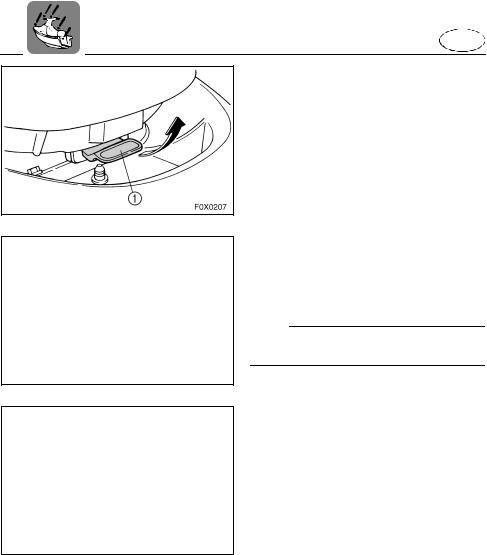
E
EJU01009
Operation of controls and other functions
EJU01010
Seat
There is a seat latch 1 at the rear of the seat to remove the seat.
To remove the seat:
Pull the seat latch up, and then pull the seat off.
To install the seat:
Insert the projection on the front of the seat into the stay on the deck, and then push the rear of the seat down to lock it in place securely.
NOTE:
Make sure that the seat is properly secured before operating the watercraft.
2-5

E
EJU01011
Hood
To open the hood, push the latch 1 down, and then lift the hood up.
To close the hood, push the hood down to lock it in place.
NOTE:
Make sure that the hood is properly secured before operating the watercraft.
EJU01012
Fuel tank filler cap
To remove the fuel tank filler cap 1, turn it counterclockwise.
NOTE:
Make sure that the fuel tank filler cap is properly secured before operating the watercraft.
EJU01013
Oil tank filler cap
To remove the oil tank filler cap 2, turn it counterclockwise.
NOTE:
Make sure that the oil tank filler cap is properly secured before operating the watercraft.
2-6

E
EJU01014
Fuel cock knob
The fuel cock supplies fuel from the fuel tank to the carburetors.
The fuel cock knob 1 positions are explained as follows and are shown in the illustration.
OFF:
With the fuel cock knob in this position, fuel does not flow. Always turn the fuel cock knob to this position when the engine is not running.
ON:
With the fuel cock knob in this position, fuel flows to the carburetors. Turn the fuel cock knob to this position when starting the engine and operating the watercraft.
RES:
This indicates reserve. With the fuel cock knob in this position, the fuel reserve is made available. Turn the fuel cock knob to this position if you run out of fuel while operating the watercraft. When this occurs, refuel as soon as possible and be sure to turn the fuel cock knob back to “ON”!
2-7
